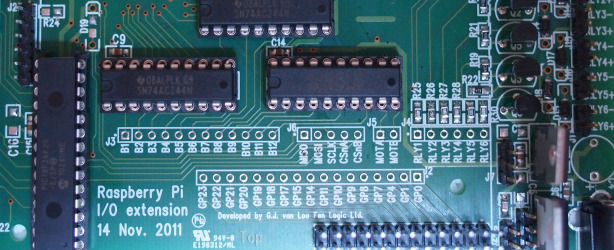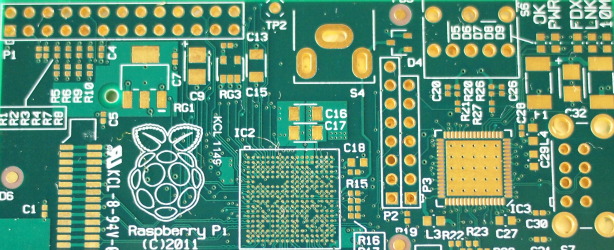Raspberry Pi: the modder's dream machine?
January 26, 2012 | 08:25
Companies: #arm #broadcom #raspberry-pi

The real beauty of the Raspberry Pi platform is, of course, its modding potential. The device has already enjoyed plenty of attention from those looking to incorporate the compact system into their projects, from case designs - including one from forum member Jake123456 - to add-on boards that take full advantage of the GPIO capabilities integral to the design.
Perhaps the most impressive of these is the Gertboard, designed by Upton’s colleague Gert van Loo as a method of interfacing hardware with the Raspberry Pi in a similar way to the microcontroller-based Arduino prototyping platform. ‘Gert is special, because he works at Broadcom therefore has access to beta boards, to schematics - Gert actually designed the ARM component of the Raspberry Pi, Gert and I together,’ Upton explained. ‘He did the hardware design for the ARM element of the BCM2835. He has an advantage, and that's why he's out there ahead in terms of actually having developed something.’
There are plenty of non-Broadcom employees looking at novel uses for the Pi, too. ‘I've seen some great proposals for various balloon, rocket, and/or satellite applications - people who want to stick these things into space,’ Upton recalled. ‘What else have we seen? Lots of home automation proposals, lots of robotics apps, some car apps - people who want to - possibly unrealistically - connect them to the EMS [Engine Management System] componentry in the car, but a lot of people wanting to do in-car entertainment type apps too.’
There are a few things to be aware of with the first batch of boards, Upton warned, including the fact that the initial production run of 10,000 will be limited to Model B units. ‘Mounting holes were sacrificed for the first run of boards, he added; a move which could make things difficult for modders looking to build custom cases for the bare PCBs. ‘What we will have is a kind of point release of the design which adds mounting holes back in. Until then, people are going to have to come up with clever ways of holding on to the board: you can come up with a case which will hold the board, it just has to be carefully designed to hold on to the board around the edges of the board, where there's space.’
Overclocking - something many have wondered about, given the Broadcom SoC’s relatively puny clock speed - could prove a challenge, too. ‘This is a mobile phone chip,’ Upton explained. ‘The limitation of overclocking is not thermal dissipation, like you would have in a desktop machine where if you overclock it and it stops working, you push the voltage up to the chip to make the circuitry run faster and you can then sustain a higher clock rate, but the chip is then consuming more power both because it's running faster and because it's got more voltage. The limitation here isn't that: the limitation here is chip lifetime. The voltage this chip runs at, you can't just give it a significant voltage overhead without harming the overall chip lifetime.’
The proof of the Raspberry Pi’s potential, however, will be in the final hardware. For those looking to get their hands on real hardware, for whom the joys of an incredibly detailed SketchUp representation aren’t enough, there’s only one question: when can we get one? ‘We're being told it's another couple of weeks by our manufacturer,’ Upton claimed, ‘so we'll see.’
Got an idea for a Raspberry Pi mod? Share it over on the forums.
Perhaps the most impressive of these is the Gertboard, designed by Upton’s colleague Gert van Loo as a method of interfacing hardware with the Raspberry Pi in a similar way to the microcontroller-based Arduino prototyping platform. ‘Gert is special, because he works at Broadcom therefore has access to beta boards, to schematics - Gert actually designed the ARM component of the Raspberry Pi, Gert and I together,’ Upton explained. ‘He did the hardware design for the ARM element of the BCM2835. He has an advantage, and that's why he's out there ahead in terms of actually having developed something.’
There are plenty of non-Broadcom employees looking at novel uses for the Pi, too. ‘I've seen some great proposals for various balloon, rocket, and/or satellite applications - people who want to stick these things into space,’ Upton recalled. ‘What else have we seen? Lots of home automation proposals, lots of robotics apps, some car apps - people who want to - possibly unrealistically - connect them to the EMS [Engine Management System] componentry in the car, but a lot of people wanting to do in-car entertainment type apps too.’
There are a few things to be aware of with the first batch of boards, Upton warned, including the fact that the initial production run of 10,000 will be limited to Model B units. ‘Mounting holes were sacrificed for the first run of boards, he added; a move which could make things difficult for modders looking to build custom cases for the bare PCBs. ‘What we will have is a kind of point release of the design which adds mounting holes back in. Until then, people are going to have to come up with clever ways of holding on to the board: you can come up with a case which will hold the board, it just has to be carefully designed to hold on to the board around the edges of the board, where there's space.’
Overclocking - something many have wondered about, given the Broadcom SoC’s relatively puny clock speed - could prove a challenge, too. ‘This is a mobile phone chip,’ Upton explained. ‘The limitation of overclocking is not thermal dissipation, like you would have in a desktop machine where if you overclock it and it stops working, you push the voltage up to the chip to make the circuitry run faster and you can then sustain a higher clock rate, but the chip is then consuming more power both because it's running faster and because it's got more voltage. The limitation here isn't that: the limitation here is chip lifetime. The voltage this chip runs at, you can't just give it a significant voltage overhead without harming the overall chip lifetime.’
The proof of the Raspberry Pi’s potential, however, will be in the final hardware. For those looking to get their hands on real hardware, for whom the joys of an incredibly detailed SketchUp representation aren’t enough, there’s only one question: when can we get one? ‘We're being told it's another couple of weeks by our manufacturer,’ Upton claimed, ‘so we'll see.’
Got an idea for a Raspberry Pi mod? Share it over on the forums.

MSI MPG Velox 100R Chassis Review
October 14 2021 | 15:04










Want to comment? Please log in.